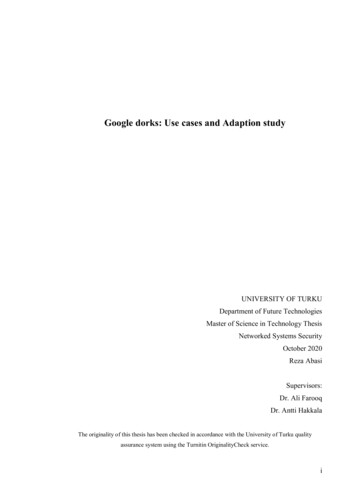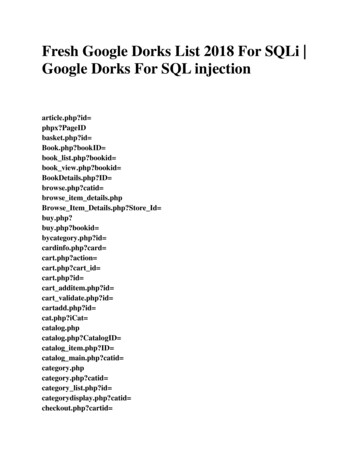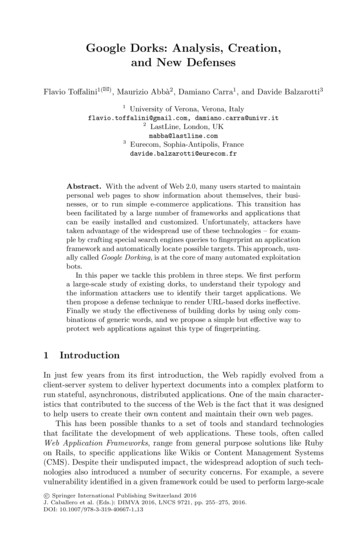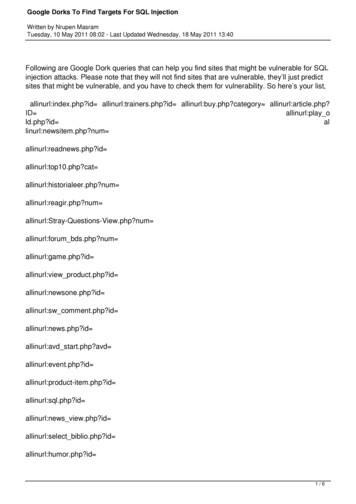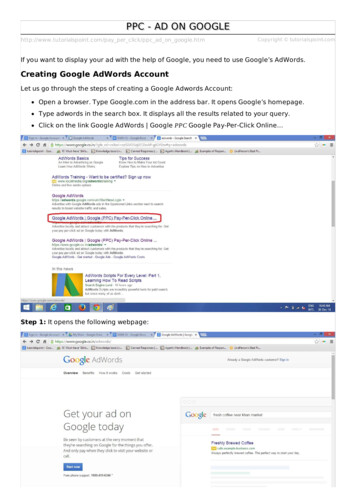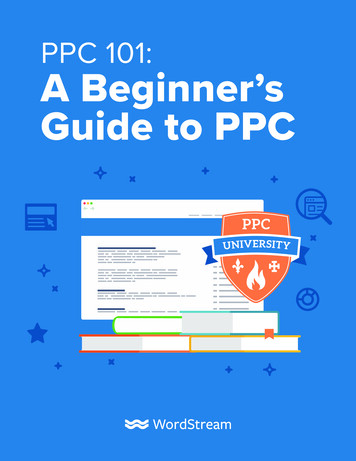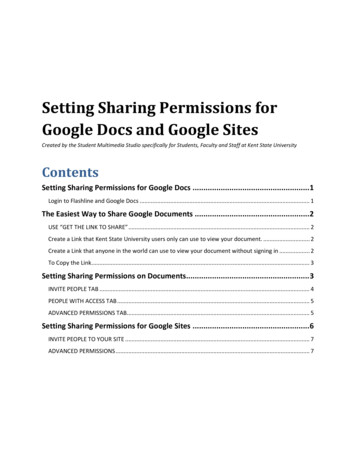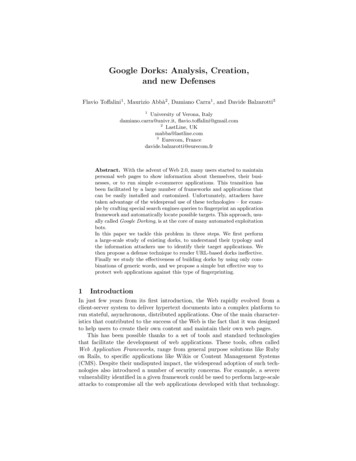
Transcription
Google Dorks: Analysis, Creation,and new DefensesFlavio Toffalini1 , Maurizio Abbà2 , Damiano Carra1 , and Davide Balzarotti31University of Verona, Italydamiano.carra@univr.it, flavio.toffalini@gmail.com2LastLine, UKmabba@lastline.com3Eurecom, Francedavide.balzarotti@eurecom.frAbstract. With the advent of Web 2.0, many users started to maintainpersonal web pages to show information about themselves, their businesses, or to run simple e-commerce applications. This transition hasbeen facilitated by a large number of frameworks and applications thatcan be easily installed and customized. Unfortunately, attackers havetaken advantage of the widespread use of these technologies – for example by crafting special search engines queries to fingerprint an applicationframework and automatically locate possible targets. This approach, usually called Google Dorking, is at the core of many automated exploitationbots.In this paper we tackle this problem in three steps. We first performa large-scale study of existing dorks, to understand their typology andthe information attackers use to identify their target applications. Wethen propose a defense technique to render URL-based dorks ineffective.Finally we study the effectiveness of building dorks by using only combinations of generic words, and we propose a simple but effective way toprotect web applications against this type of fingerprinting.1IntroductionIn just few years from its first introduction, the Web rapidly evolved from aclient-server system to deliver hypertext documents into a complex platform torun stateful, asynchronous, distributed applications. One of the main characteristics that contributed to the success of the Web is the fact that it was designedto help users to create their own content and maintain their own web pages.This has been possible thanks to a set of tools and standard technologiesthat facilitate the development of web applications. These tools, often calledWeb Application Frameworks, range from general purpose solutions like Rubyon Rails, to specific applications like Wikis or Content Management Systems(CMS). Despite their undisputed impact, the widespread adoption of such technologies also introduced a number of security concerns. For example, a severevulnerability identified in a given framework could be used to perform large-scaleattacks to compromise all the web applications developed with that technology.
Therefore, from the attacker viewpoint, the information about the technologyused to create a web application is extremely relevant.In order to easily locate all the applications developed with a certain framework, attackers use so-called Google Dork Queries [1] (or simply dorks). Informally, a dork is a particular query string submitted to a search engine, craftedin a way to fingerprint not a particular piece of information (the typical goal of asearch engine) but the core structure that a web site inherits from its underlyingapplication framework. In the literature, different types of dorks have been usedfor different purposes, e.g., to automatically detect mis-configured web sites orto list online shopping sites that are built using a particular CMS.The widespread adoption of frameworks on one side, and the ability to abusesearch engines to fingerprint them on the other, had a very negative impact onweb security. In fact, this combination lead to complete automation, with attackers running autonomous scout and exploitation bots, which scan the webfor possible targets to attack with the corresponding exploit [2]. Therefore, webelieve that a first important step towards securing web applications consists ofbreaking this automation. Researcher proposed software diversification [3] as away to randomize applications and diversify the targets against possible attacks.However, automated diversification approaches require complex transformationsto the application code, are not portable between different languages and technologies, often target only a particular class of vulnerabilities, and, to the bestof our knowledge, have never been applied to web-based applications.In this paper we present a different solution, in which a form of diversificationis applied not to prevent the exploitation phase, but to prevent the attackersfrom fingerprinting vulnerable applications. We start our study by performinga systematic analysis of Google Dorks, to understand how they are created andwhich information they use to identify their targets. While other researchershave looked at the use of dorks in the wild [4], in this paper we study theircharacteristics and their effectiveness from the defendant viewpoint. We focus inparticular on two classes of dorks, those based on portions of a website URL, andthose based on a specific sequence of terms inside a web page. For the first class,we propose a general solutions – implemented in an Apache Module – in whichwe obfuscate the structure of the application showing to the search engine onlythe information that is relevant for content indexing. Our approach does notrequire any modification to the application, and it is designed to work togetherwith existing search engine optimization techniques.If we exclude the use of simple application banners, dorks based on genericword sequences are instead rarely used in practice. Therefore, as a first step wecreated a tool to measure if this type of dorks is feasible, and how accurate it isin fingerprinting popular CMSes. Our tests show that our technique is able togenerate signatures with over 90% accuracy. Therefore, we also discuss possiblecountermeasures to prevent attackers from building these dorks, and we proposea novel technique to remove the sensitive framework-related words from searchengines results without removing them from the page and without affecting theusability of the application.
To conclude, this paper makes the following contributions:– We present the first comprehensive study of the mechanisms used by dorksand we improve the literature classification in order to understand the mainissues and develop the best defenses.– We design and implement a tool to block dorks based on URL informationwithout changing the Web application and without affecting the site rankingin the search engines.– We study dorks based on combinations of common words, and we implementa tool to automatically create them and evaluate their effectiveness. Ourexperiments demonstrate that it is possible to build a dork using non-trivialinformation left by the Web application framework.– We propose a simple but effective countermeasure to prevent dorks based oncommon words, without removing them from the page.Thanks to our techniques, we show that there are no more information available for an attacker to identify a web application framework based on the queriesand the results displayed by a search engine.2Background and classificationThe creation, deployment and maintenance of a website are complex tasks. Inparticular, if web developers employ modern CMSes, the set of files that composea website contain much more information than the site content itself and suchunintentional traces may be used to identify possible vulnerabilities that can beexploited by malicious users.We identify two types of traces: (i) traces left by mistake that expose sensitiveinformation on the Internet (e.g., due to misconfiguration of the used tool), and(ii) traces left by the Web Application Framework (WAF) in the core structureof the website. While the former type of traces is simple to detect and remove,the latter can be seen as a fingerprint of the WAF, which may not be easy toremove since it is part of the WAF itself.There are many examples of traces left by mistake. For instance, log filesrelated to the framework installation may be left in public directories (indexedby the search engines). Such log files may show important information relatedto the machine where the WAF is installed. The most common examples relatedto the fingerprint of a WAF are the application banners, such as “Powered byWordpress”, which contain the name of the tool used to create the website.Google Dorks still lack a formal definition, but they are typically associatedto queries that take advantage of advanced operators offered by search engines toretrieve a list of vulnerable systems or sensitive information. Unfortunately thiscommon definition is vague (what type of sensitive information?) and inaccurate(e.g., not all dorks use advanced operators). Therefore, in this paper we adopta more general definition of dorks: any query whose goal is to locate web sitesusing characteristics that are not based on the sites content but on their structureor type of resources. For example, a search query to locate all the e-commerce
applications with a particular login form is a dork, while a query to locate ecommerce applications that sell Nike shoes is not.Dorks often use advance operators (such as inurl to search in a URL) tolook for specific content in the different parts of the target web sites. Below, weshow two examples of dorks, where the attacker looks for an installation log (leftby mistake) or for a banner string (used to fingerprint a certain framework):inurl :" installer - log . txt " AND intext :" DUPLICATOR INSTALL - LOG "intext :" Powered by Wordpress "Note that all search engine operators can only be used to search keywordsthat are visible to the end users. Any information buried in the HTML code,but not visible, cannot be searched. This is important, since it is often possibleto recognize the tool that produced a web page by looking at the HTML code,an operation that however cannot be done with a traditional search engine.Since there are many different types of information that can be retrievedfrom a search engine, there are many types of dorks that can be created. In thefollowing, we revise the classification used so far in the literature.2.1Existing Dorks ClassificationPrevious works (for a complete review, please refer to Section 6) divide dorks intodifferent categories, typically following the classification proposed in the GoogleHacking Database (GHDB) [5, 6], which contains 14 categories. The criteriaused to define these categories is the purpose of the dork, i.e., which type ofinformation an attacker is trying to find. For instance, some of the categoriesare:Advisories and vulnerabilities: it contains dorks that are able to locate various vulnerable servers, which are product or version-specific.Sensitive directories: these dorks try to understand if some directories (withsensitive information) that should remain hidden, are made public.Files containing passwords: these dorks try to locate files containing passwords.Pages containing login portals: it contains dorks to locate login pages forvarious services; if such pages are vulnerable, they can be the starting pointto obtain other information about the system.Error messages: these dorks retrieve the pages or the files with errors messagesthat may contain some details about the system.Different categories often rely on different techniques – such as the use ofsome advance operators or keywords – and target different parts of a website –such as its title, main body, files, or directories.While this classification may provide some hints on the sensitive informationa user should hide, the point of view is biased towards the attacker. From thedefendant point of view, it would be useful to have a classification based on thetechniques used to retrieve the information, so that it would be possible to check
if a website is robust against such techniques (independently from the aim forwhich the technique is used). For this reason, in this paper we adopt a differentclassification based on the characteristics of the dorks.2.2Alternative classificationWe implemented a crawler to download all the entries in the GHDB [5, 6] anda set of tools to normalize each dork and automatically classify it based on theinformation it uses4 .We have identified three main categories, which are not necessarily disjointand may be combined together in a single query:URL Patterns: This category contains the dorks that use information presentin the structure of the URL.Extensions: It contains the dorks used to search files with a specific extension,typically to locate misconfigured pages.Content-Based: These dorks use combination of words in the content of thepage – both in the body, and in the title.Since the content-based category is wide, we subsequently split such categoryinto four sub-categories:Application Banners: This category contains strings or sentences that identify the underlying WAF (e.g., “Powered by Wordpress”). These banners canbe found in the body of the page (often in the foothold) or in the title.Misconfiguration Strings: This category contains strings which correspondto sensitive information left accessible by mistake by human faults (suchas database logs, string present in configuration files, or part of the defaultinstallation pages)Errors Strings: Dorks in this category use special strings to locate unhandlederrors, such as the ones returned when a server-side script is not able to reada file or it processes wrong parameters. Usually, besides the error, it is alsopossible to find on the page extra data about the server-side program, orother general information about the system.Common Words: This class contains the dorks that do not fit in the othercategories. They are based on combinations of common words that are notrelated to a particular application. For instance, these dorks may search for(“insert”, “username”, and “help”) to locate a particular login page.Table 2.2 shows the number of dorks for each category. Since some of thedorks belongs to different categories, the sum of all categories is greater thanthe total number of entries. The classification shows that most of the dorks arebased on banners and URL patterns. In particular, 89.5% of the existing dorksuse either a URL or a banner in their query.4Not all dorks have been correctly classified automatically, so we manually inspectedthe results to ensure a correct classification.
CategoryURL PatternExtensionsNumber Perc. tent-basedErrors711Common words58711Total entries in GHDB [6]5143Table 1. Number of dorks and relative percentage for the different categories. Sincea dork may belong to different categories, the sum of the entries of all categories isgreater than the total number of entries extracted from GHDB.Fig. 1. Dorks evolution by category.Besides the absolute number of dorks, it is interesting to study the evolutionof the dork categories over time. This is possible since the data from GHDB [6]contains the date in which the dork was added to the database. Figure 1 showsthe percentage over time of the proposed dorks, grouped by category. It is interesting to note that banner-based dorks are less and less used in the wild,probably as a consequence of users removing those strings from their application. In fact, their popularity decreased from almost 60% in 2010 to around 20%in 2015 – leaving URL-based dorks to completely dominate the field.2.3Existing DefensesSince the classification of the dorks has traditionally taken the attacker viewpoint, there are few works that provide practical information about possible defenses. Most of the them only suggests some best practices (e.g., remove all sensitive information), without describing any specific action. Unfortunately, someof these best practice are not compatible with Search Engine Optimizations(SEOs). SEOs are a set of techniques used to improve the webpage rank – e.g.,by including relevant keywords in the URL, in the title, or in the page headers.When removing a content, one should avoid to affect such SEOs.As previously noted, most of the dorks are based on banners and URL patterns, with mis-configuration strings at the third place. While this last category
is a consequence of human faults, which are somehow easier to detect, the otherdorks are all based on the fingerprint of the WAFs.Banners are actually simple to remove, but the URL patterns are considerably more complex to handle. In fact, the URL structure is inherited from theunderlying framework, and therefore one should modify the core structure of theWAF itself – a task too complex and error prone for the majority of the users.Finally, word-based dorks are even harder to handle because it is not obviouswhich innocuous words can be used to precisely identify a web application.In both cases we need effective countermeasures that are able to neutralizesuch dorks. In the next sections, we show our solutions to these issues.3Defeating URL-based DorksThe URLs of a web application can contain two types of information. The firstis part of the structure of the web application framework, such as the nameof sub-directories, and the presence of default administration or login pages.The second is part of the website content, such as the title of an article or thename of a product (that can also be automatically generated by specific SEOoptimization plugins). While the second part is what a search engine shouldcapture and index, we argue that there is no reason for search engines to alsomaintain information about the first one.The optimal solution to avoid this problem would be to apply a set of randomtransformations to the structure of the web application framework. However, thediversity and complexity of these frameworks would require to develop an ad-hocsolution for each of them. To avoid this problem, we implement the transformation as a filter in the web server. To be usable in practice, this approach needsto satisfy some constraints. In particular, we need a technique that:1. It is independent from the programming language and the WAF used todevelop the web site.2. It is easily deployable on an existing web application, without the need tomodify the source code.3. It supports dynamically generated URLs, both on the server side and on theclient side (e.g., through Javascript).4. It can co-exist with SEO plugins or other URL-rewriting components.The basic idea of our solution is to obfuscate (part of) the URLs using arandom string generated at installation time. Note that the string needs to berandom but it does not need to be secret, as its only role is to prevent anattacker for computing a single URL that matches all the applications of a givetype accessible on the Web.Our solution relies on two components: first, it uses standard SEO techniquesto force search engines to only index obfuscated URLs, and then applies a filterinstalled in the web server to de-obfuscate the URLs in the incoming requests.
3.1URL ObfuscationThe obfuscation works simply by XOR-ing part of the original URL with therandom seed. Our technique can be used in two different ways: for selectiveprotection or for global protection. In the first mode, it obfuscates only particularpieces of URLs that are specified as regular expressions in a configuration file.This can be used to selectively protect against known dorks, for instance basedon particular parameters or directory names.When our solution is configured for global protection, it instead obfuscate allthe URLs, except for possible substrings specified by regular expressions. Thismode provides a better protection and simplifies the deployment. It can alsoco-exist with other SEO plugins, by simply white-listing the portions of URLsused by them (for example, all the URLs under /blog/posts/*). The advantageof this solution is that it can be used out-of-the-box to protect the vast majorityof small websites based on popular CMSs. But it can also be used, by properlyconfiguring the set of regular expressions, to protect more complex websites thathave specific needs and non-standard URL schemes.Finally, the user can choose to apply the obfuscation filter only to particular UserAgent strings. Since the goal is to prevent popular search engines fromindexing the original URLs, the entire solution only needs to be applied to therequests coming from their crawlers. As we discuss in the next session, our technique works also if applied to all incoming requests, but this would incur aperformance penalty for large websites. Therefore, by default our deploymentonly obfuscates the URLs provided to a configurable list of search engines5 .3.2Delivering Obfuscated URLsIn this section, we explain our strategy to show obfuscated URLs, and hidethe original ones, in the results of search engines. The idea is to influence thebehavior of the crawlers by using common SEO techniques.Redirect 301 The Redirect 301 is a status code of the HTTP protocol used forpermanent redirection. As the name suggests, it is used when a page changesits URL, in combination with a “Location” header to specify the new URL tofollow. When the user-agent of a search engine sends a request for a cleartextURL, our filter returns a 301 error with a pointer to the obfuscated URL.The advantage of this technique is that it relies on a standard error codewhich is supported by the all the search engines we tested. Another advantageof this approach is that the search engines move the current page rank over tothe target of the redirection. Unfortunately, using the 301 technique alone is notsufficient to protect a page, as some search engines (Google for instance) wouldstore in their database both the cleartext and the obfuscated URL.Canonical URL Tag The Canonical URL Tag is a meta-tag mainly used inthe header of the HTML documents. It is also possible to use this tag as HTTP5Here we assume that search engines do not try to disguise their requests, as it is thecase for all the popular ones we encountered in our study
header to manage non-HTML documents, such as PDF files and images. Its mainpurpose is to tell search engines what is the real URL to show in their results.For instance, consider two pages that show the same data, but generatedwith a different sorting parameter, as follow:http://www.abc.com/order-list.php?orderby data&direct aschttp://www.abc.com/order-list.php?orderby cat&direct descIn the example above, the information is the same but the two pages risk tobe indexed as two different entries. The Canonical tag allows the site owner toshow them as a single entry, improving the page rank. It is also important thatthere is only a single tag in the page, as if more tags are presents search engineswould ignore them all.Our filter parses the document, and it injects a Canonical URL Tag with theobfuscated URL. To avoid conflict with other Canonical URL Tags, we detecttheir presence and replace their value with the corresponding obfuscated version.A drawback of this solution is that the Canonical URL Tag needs to containa URL already present in the index of the search engine. If the URL is notindexed, the search engine ignores the tag. This is the reason why we use thistechnique in conjunction with the 301 redirection.Site Map The site map is an XML document that contains all the public linksof a web site. The crawler uses this document to get the entire list of the URLsto visit. For instance, this document is used in blogs to inform the search engineabout the existence of new entries, as for the search engine it is more efficient topoll a single document rather than crawling the entire site each time.If a search engine tries to get a site map, our filter replaces all the URLs withtheir obfuscated versions. This is another technique to inform the crawler aboutthe site structure and populate its cache with the obfuscated URLs.Obfuscation Protocol In this section, we show how the previous techniquesare combined together to obtain our goal. Figure 2 shows the behavior of our toolwhen a crawler visits a protected web site. When the crawler requests a resource‘a’ our tool intercepts the request and redirect it to the obfuscated URL O(a).The crawler then follows the redirect and requests the obfuscated resource. Inthis case, the system de-obfuscates the request, and then serves it according tothe logic of the web site. When the application returns the result page, our filteradds the Canonical URL Tag following the rules described previously.In Fig.2, we also show how the tool behaves when normal users visit the website. Typically, users would first request an obfuscated URL (as returned by aquery to a search engine, for example). In this case, the request is de-obfuscatedand forwarded to the web application as explained before. This action incursa small penalty in the time required to serve the requests. However, once theuser gets the page back, he can interact with the websites following links and/orforms that contain un-obfuscated URLs. In this case, the requests are served bythe web server without any additional computation or delay.Even if this approach might appear as a form of cloaking, the clocking definition requires an application to return different resources for a crawler and for
BrowserURL ObfuscatorWeb siteO(a)aCrawlerURL ObfuscatorWeb siteresp. of aresp. of aaredirect to O(a)bbO(a)aresp. of bresp. of bresp. of aresp. of a canonical tagFig. 2. On the left side: messages exchanged between a protected application ad anormal user. On the right side: messages exchanged between a protected applicationand a search engine crawler.other clients, as described in the guidelines of the major search engines [7–9].Our technique only adds a meta-tag to the page, and does not modify the restof the content and its keywords.3.3ImplementationOur approach is implemented as a module for the Apache web server. Whena web site returns some content, Apache handles the data using the so-calledbuckets and brigades. Basically, a bucket is a generic container for any kind ofdata, such as a HTML page, a PDF document, or an image. In a bucket, datais simply organized in an array of bytes. A brigade is a linked list of buckets.The Apache APIs allow to split a bucket and re-link them to the correspondingbrigade. Using this approach, it is possible to replace, remove, or append bytesto a resource, without re-allocating space. We use this technique to insert theCanonical URL Tag in the response, and to modify the site map. In addition,the APIs also permit to manage the header of the HTTP response, and our tooluse this feature in order to add the Canonical URL Tag in the headers.Since the Apache server typically hosts several modules simultaneously, wehave configured our plugin to be the last, to ensure that the obfuscation is appliedafter any other URL transformation or rewriting step. Our obfuscation moduleis also designed to work in combination with the deflate module. In particular,it preserves the compression for normal users but it temporarily deactivate themodule for requests performed by search engine bots. The reason is that a clientcan request a compressed resource, but in this case our module is not able toparse the compressed output to insert the Canonical Tag or to obfuscate theURLs in the site-map. Therefore, our solution removes the output compressionfrom the search engine requests – but still allows compressed responses in allother cases.Finally, to simplify the deployment of our module, we developed an installation tool that takes as input a web site to protect, generate the random seed,
analyzes the site URL schema to create the list of exception URLs, and generatethe corresponding snippet to insert into the Apache configuration file. This issufficient to handle all simple CMS installations, but the user can customize theautomatically generated configuration to accommodate more complex scenarios.3.4Experiments and resultsWe tested our solution on Apache 2.4.10 running two popular CSMs: Joomla!3.4, and Wordpress 4.2.5. We checked that our websites could be easily identifiedusing dorks based on “inurl:component/user” and “inurl:wp-content”.We then protected the websites with our module and verified that a numberof popular search engines (Google, Bing, AOL, Yandex, and Rambler) were onlyable to index the obfuscated URLs and therefore our web sites were no longerdiscoverable using URL-based dorks.Finally, during our experiments we also traced the number of requests wereceived from search engines. Since the average number was 100 access per day,we believe that our solution does not have any measurable impact on the performance of the server or on the network traffic.4Word-based DorksAs we already observed in the Section 2, dorks based on application banners arerapidly decreasing in popularity, probably because users started removing thesebanners from their web applications. Therefore, it is reasonable to wonder if isalso possible to create a precise fingerprint of an application by using only a setof generic and seemingly unrelated words.This section is devoted to this topic. In the first part we show that it is indeed possible to automatically build word-based dorks for different content management systems. Such dorks may be extremely dangerous because the queriessubmitted to the search engines are difficult to detect as dorks (since they donot use any advanced operator or any string clearly related to the target CMS).In the second part, we discuss possible countermeasures for this type of dorks.4.1Dork CreationGiven a set of words used by a CMS, the search for the optimal combinationthat can be used as fingerprint has clearly an exponential complexity. Therefore,we need to adopt a set of heuristics to speed up the generation process. Beforeintroducing our technique we need to identify the set of words to analyze, andthe criteria used to evaluate such words.Building Blocks The first step to build a dork is to extract the set of wordsthat may characterize the CMS. To this aim, we start from a vanilla installationof the target website framework, without any modification or personalization.From this clean instance, we remove the default lorem ipsum content, such as“Hello world” or
Google Dorks still lack a formal de nition, but they are typically associated to queries that take advantage of advanced operators o ered by search engines to retrieve a list of vulnerable systems or sensitive information. Unfortunately this common de nition is vague (what type of sensitive information?) and inaccurate
